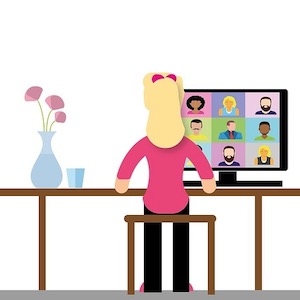How To Optimize Your Leadership Effectiveness When Working from Home
 Over the past few years, many companies have shifted their operations to a work-from-home model. While this has presented numerous challenges for managers and staff members alike, it has also created an opportunity to optimize leadership and team impact in unique ways. However, in order to do so, leaders must adapt to and overcome the unique obstacles of remote work.
Over the past few years, many companies have shifted their operations to a work-from-home model. While this has presented numerous challenges for managers and staff members alike, it has also created an opportunity to optimize leadership and team impact in unique ways. However, in order to do so, leaders must adapt to and overcome the unique obstacles of remote work.
According to recent YouGov statistics, women place more emphasis on the importance of job flexibility than their male colleagues. Not only do 57% of women say that flexible working hours are very important (compared to 44% of men), but almost three-quarters of female respondents (72%) said they want a flexible working location compared to just 57% of men.
When it comes to leadership roles, further research suggests that remote working arrangements give more women the opportunity to be in positions of responsibility. In fact, of the 129 remote companies surveyed, 29% had women in leadership positions (CEO, founder or president). Meanwhile, for traditional companies on the Fortune 500 list, this figure sits below 5%.
In this blog post, we will explore a variety of tips and best practices for optimizing leadership effectiveness while working from home. Whether you’re a seasoned remote worker or are still acclimatizing to the modern working world, this guide will provide valuable insights for cultivating productivity, engagement, and overall success.
Encourage constructive feedback/have individual check-ins
Among the many challenges of remote working is the potential feeling of disconnectedness between team members. When in-person meetings happen less frequently and those impromptu morning catch-ups go by the wayside, it’s harder to form meaningful professional relationships with your teammates.
While it’s incumbent upon each team member to make a concerted effort to form these bonds, ultimately the manager has a pivotal role in generating that team spirit and feeling of belonging.
There are a number of ways in which this can be accomplished, but organizing one-to-one check-ins can be a great starting point. Encourage your staff to come to these meetings with honest feedback about things the team or you as an individual could do differently to enhance their wellbeing in the workplace.
Not only do these regular meetings provide the opportunity for virtual contact, but they’re also a great way to ascertain the thoughts and feelings of the team. If they feel able to provide feedback and know that it’s going to be taken seriously, that can go a long way to helping them feel part of the bigger picture.
Balance the company’s needs with the people’s
One of the biggest battles for any business owner is striking a balance between pursuing long-term goals with the individual needs of their employees. Often, owners and managers can become preoccupied with setting KPIs and tracking metrics that the human element to the world of business can be an afterthought. Essentially, leaders need to consider how they can support staff to have a healthy split between their work and personal lives, whilst also ensuring the company continues to move forward.
For some, work and life has been easier to balance since working remotely, with the removal of commutes giving professionals some extra time back each day. For others, the expectation to always be ‘online’ and constant temptation to check back in after working hours makes it difficult to detach themselves from their professional responsibilities.
According to research, women are more likely to do informal work to promote DEI within their company. Female leaders are also more likely to support the ‘people’ side of the business, advocating for the wellbeing of their colleagues and offering support in managing their workloads and personal challenges. However, while this ‘extra-curricular’ support can be invaluable to employees, it can often lead to female professionals overburdening themselves and sacrificing their own wellbeing as a result.
As a manager, it’s important you lead by example, and set your own boundaries when it comes to working hours. You should make it clear when you can and can’t be contacted for work-related issues – consider setting your hours on your digital calendar or workplace communication platform. Not only will this provide clarity around when people can expect a response from you, but it will also hopefully encourage them to do the same, and keep a clear distinction between work and personal life.
Develop your communication skills
Strong communication is one of the most important aspects of effective leadership, but this can be more difficult to demonstrate when face-to-face conversations are no longer an option. When exclusively communicating to colleagues via online communication tools, there is more opportunity for words to be misinterpreted, which could mean they end up having a harmful effect on the team. At the same time, you want to make your presence felt as a leader, and avoid going days without having any contact with your colleagues.
To get the most out of these digital communication tools, it’s important to understand the role of different platforms. For example, you may not need to organize a virtual meeting to discuss a minor query about a piece of work. Not only is this disruptive to your colleagues’ schedules, but the message is likely to be diluted when communicated in this way. Think carefully about the appropriate times to use emails, instant messaging platforms, phone calls or video conferencing, to streamline your communication and have a more positive impact on the wider team.
By: Elizabeth Fletcher – She writes posts designed to help businesses and employees to come together and create a productive, healthy workplace. She believes that good communication and collaboration are key to a happy working life.
(The opinions and views of guest contributions are not necessarily those of theglasshammer.com).










